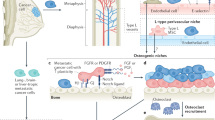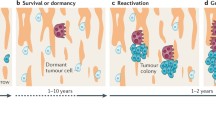Abstract
Bone metastasis is a common incurable complication of breast cancer affecting around 70% of patients with advanced disease. In order to improve outcomes for these patients, the cellular and molecular mechanisms underlying bone metastasis need to be established. The majority of studies to date have focused on end-stage disease and little is known about the events taking place following initial tumour cell colonisation of bone. Here we report the results of a longitudinal study that provides detailed analysis of the spatial and temporal relationship between bone and cancer cells during progression of bone metastasis. Tumour growth in bone was initiated by intra-cardiac inoculation of MDA-MB-231-GFP breast cancer cells in immunocompromised mice. Differentiating between areas of bone in direct contact with the tumour and areas distal to the cancer cells but within the tumour bearing bone, we performed comprehensive analyses of the number and distribution of osteoclasts and osteoblasts. Tumour colonies were detectable in bone from day 10, while reduced trabecular bone volume was apparent from day 19 onwards. Cancer-induced changes in osteoblast and osteoclast numbers differed substantially depending on whether or not the cells were in direct contact with the tumour. Compared to naïve controls, areas of bone in direct contact with the tumour had significantly reduced osteoblast but increased osteoclast numbers, whereas the reverse was found in distal areas. Our data demonstrate that tumour cells induce substantial changes in the bone microenvironment prior to the appearance of bone lesions, suggesting that early therapeutic intervention may be required to oppose the tumour-induced changes to the microenvironment und thus tumour progression.






Similar content being viewed by others
Abbreviations
- Oc:
-
Osteoclast
- Ob:
-
Osteoblast
- PINP:
-
Procollagen type I N-terminal propeptide
- uCT:
-
Microcomputed tomography
- ELISA:
-
Enzyme-linked immunoassay
- H&E:
-
Hematoxylin and eosin
- TRAP:
-
Tartrate-resistant acid phosphatase
- GFP:
-
Green fluorescent protein
- NBP:
-
Nitrogen-containing bisphosphonate
References
Mundy GR (1997) Mechanisms of bone metastasis. Cancer 80(8 Suppl):1546–1556
Green JR (2003) Antitumor effects of bisphosphonates. Cancer 97(3 Suppl):840–847
Coxon FP, Helfrich MH, Van’t Hof R et al (2000) Protein geranylgeranylation is required for osteoclast formation, function, and survival: inhibition by bisphosphonates and GGTI-298. J Bone Miner Res 15(8):1467–1476
Dunford JE, Thompson K, Coxon FP et al (2001) Structure–activity relationships for inhibition of farnesyl diphosphate synthase in vitro and inhibition of bone resorption in vivo by nitrogen-containing bisphosphonates. J Pharmacol Exp Ther 296(2):235–242
Roelofs AJ, Thompson K, Ebetino FH et al (2010) Bisphosphonates: molecular mechanisms of action and effects on bone cells, monocytes and macrophages. Curr Pharm Des 16(27):2950–2960
van Beek E, Pieterman E, Cohen L et al (1999) Farnesyl pyrophosphate synthase is the molecular target of nitrogen-containing bisphosphonates. Biochem Biophys Res Commun 264(1):108–111
Fromigue O, Lagneaux L, Body JJ (2000) Bisphosphonates induce breast cancer cell death in vitro. J Bone Miner Res 15(11):2211–2221
Sasaki A, Boyce BF, Story B et al (1995) Bisphosphonate risedronate reduces metastatic human breast cancer burden in bone in nude mice. Cancer Res 55(16):3551–3557
van der Pluijm G, Que I, Sijmons B et al (2005) Interference with the microenvironmental support impairs the de novo formation of bone metastases in vivo. Cancer Res 65(17):7682–7690
Yoneda T, Michigami T, Yi B et al (2000) Actions of bisphosphonate on bone metastasis in animal models of breast carcinoma. Cancer 88(12 Suppl):2979–2988
Croucher PI, De Hendrik R, Perry MJ et al (2003) Zoledronic acid treatment of 5T2MM-bearing mice inhibits the development of myeloma bone disease: evidence for decreased osteolysis, tumor burden and angiogenesis, and increased survival. J Bone Miner Res 18(3):482–492
Daubine F, Le Gall C, Gasser J et al (2007) Antitumor effects of clinical dosing regimens of bisphosphonates in experimental breast cancer bone metastasis. J Natl Cancer Inst 99(4):322–330
Hiraga T, Williams PJ, Ueda A et al (2004) Zoledronic acid inhibits visceral metastases in the 4T1/luc mouse breast cancer model. Clin Cancer Res 10(13):4559–4567
Corey E, Brown LG, Quinn JE et al (2003) Zoledronic acid exhibits inhibitory effects on osteoblastic and osteolytic metastases of prostate cancer. Clin Cancer Res 9(1):295–306
Phadke PA, Mercer RR, Harms JF et al (2006) Kinetics of metastatic breast cancer cell trafficking in bone. Clin Cancer Res 12(5):1431–1440
Ottewell PD, Monkkonen H, Jones M et al (2008) Antitumor effects of doxorubicin followed by zoledronic acid in a mouse model of breast cancer. J Natl Cancer Inst 100(16):1167–1178
Chantry AD, Heath D, Mulivor AW et al (2010) Inhibiting activin-A signaling stimulates bone formation and prevents cancer-induced bone destruction in vivo. J Bone Miner Res 25(12):2633–2646
Deleu S, Lemaire M, Arts J et al (2009) Bortezomib alone or in combination with the histone deacetylase inhibitor JNJ-26481585: effect on myeloma bone disease in the 5T2MM murine model of myeloma. Cancer Res 69(13):5307–5311
Heath DJ, Chantry AD, Buckle CH et al (2009) Inhibiting Dickkopf-1 (Dkk1) removes suppression of bone formation and prevents the development of osteolytic bone disease in multiple myeloma. J Bone Miner Res 24(3):425–436
Mohanty ST, Kottam L, Gambardella A et al (2010) Alterations in the self-renewal and differentiation ability of bone marrow mesenchymal stem cells in a mouse model of rheumatoid arthritis. Arthritis Res Ther 12(4):R149
Trebec DP, Chandra D, Gramoun A et al (2007) Increased expression of activating factors in large osteoclasts could explain their excessive activity in osteolytic diseases. J Cell Biochem 101(1):205–220
Clohisy DR, Palkert D, Ramnaraine ML et al (1996) Human breast cancer induces osteoclast activation and increases the number of osteoclasts at sites of tumor osteolysis. J Orthop Res 14(3):396–402
Clohisy DR, Ogilvie CM, Carpenter RJ et al (1996) Localized, tumor-associated osteolysis involves the recruitment and activation of osteoclasts. J Orthop Res 14(1):2–6
Dhurjati R, Krishnan V, Shuman LA et al (2008) Metastatic breast cancer cells colonize and degrade three-dimensional osteoblastic tissue in vitro. Clin Exp Metastasis 25(7):741–752
Bodenstine TM, Beck BH, Cao X et al (2011) Pre-osteoblastic MC3T3-E1 cells promote breast cancer growth in bone in a murine xenograft model. Chin J Cancer 30(3):189–196
Huang Z, Cheng SL, Slatopolsky E (2001) Sustained activation of the extracellular signal-regulated kinase pathway is required for extracellular calcium stimulation of human osteoblast proliferation. J Biol Chem 276(24):21351–21358
Shiozawa Y, Pedersen EA, Havens AM et al (2011) Human prostate cancer metastases target the hematopoietic stem cell niche to establish footholds in mouse bone marrow. J Clin Invest 121(4):1298–1312
Vukmirovic-Popovic S, Colterjohn N, Lhotak S et al (2002) Morphological, histomorphometric, and microstructural alterations in human bone metastasis from breast carcinoma. Bone 31(4):529–535
Armstrong AP, Miller RE, Jones JC et al (2008) RANKL acts directly on RANK-expressing prostate tumor cells and mediates migration and expression of tumor metastasis genes. Prostate 68(1):92–104
Mendoza-Villanueva D, Zeef L, Shore P (2011) Metastatic breast cancer cells inhibit osteoblast differentiation through the Runx2/CBFbeta-dependent expression of the Wnt antagonist, sclerostin. Breast Cancer Res 13(5):R106
Kinder M, Chislock E, Bussard KM et al (2008) Metastatic breast cancer induces an osteoblast inflammatory response. Exp Cell Res 314(1):173–183
Coleman RE, Marshall H, Cameron D et al (2011) Breast-cancer adjuvant therapy with zoledronic acid. N Engl J Med 365(15):1396–1405
Acknowledgments
Breast Cancer Campaign, UK, generously supported this study. We would also like to thank Mr Ken Mann for performing the RANKL immunohistochemistry and Dr Simon Cross for his help with the evaluation of the staining.
Author information
Authors and Affiliations
Corresponding author
Electronic supplementary material
Below is the link to the electronic supplementary material.
10585_2012_9481_MOESM1_ESM.ppt
Supplementary figure 1: (A) µCT trabecular bone measurements were carried out for the proximal tibia and distal femur in non-tumour bearing bones vs. bones from naïve mice. Data are expressed as % BV/TV (bone volume/tissue volume). (B) Sera from the entire study were collected from starved animals. PINP serum levels were measured by ELISA (Rat/Mouse PINP EIA, IDS) on n=6 day 10, n=9 day 15, n=8 day 19, n=10 day 24 and n=6 EOP, naïve n=5/time point. (C) CTX serum levels were measured by ELISA (RatLaps™ EIA for CTX, IDS) on a subset of animals from the study. Day 10 n=1, day 15 n=3, day 19 n=2, day 24 n=3, EOP n=2, naïve n=2/time point. (D) Mouse RANKL serum levels were measured by ELISA (RANKL Immunoassay, Biomedica) on tumour bearing animals with n=4 at day 10, n=7 at day 15, n=5 at day 19, n=6 at day 24 and n=3 at EOP, naïve n=3/time point. (E) Sclerostin serum levels were measured by ELISA (Sclerostin Immunoassay, R&D Systems) with n numbers as in (D). Mann–Whitney test for all time points separately, * is p<0.05 (PPT 636 kb)
10585_2012_9481_MOESM2_ESM.pptx
Supplementary table 1: Relative expression of bone-related genes measured by real-time reverse transcription-PCR and normalised to GAPDH. TaqMan® assays have been tested for species specificity. In vivo subcutaneous samples (n=8) and osseous samples (n=4) are compared to in vitro control cells (MDA-MB-231-GFP, n=3). * vs. in vitro control p<0.05, ^ vs. subcutaneous tumour p<0.05. Fold changes in bold indicate bone specific changes (PPTX 56 kb)
Rights and permissions
About this article
Cite this article
Brown, H.K., Ottewell, P.D., Evans, C.A. et al. Location matters: osteoblast and osteoclast distribution is modified by the presence and proximity to breast cancer cells in vivo. Clin Exp Metastasis 29, 927–938 (2012). https://doi.org/10.1007/s10585-012-9481-5
Received:
Accepted:
Published:
Issue Date:
DOI: https://doi.org/10.1007/s10585-012-9481-5




